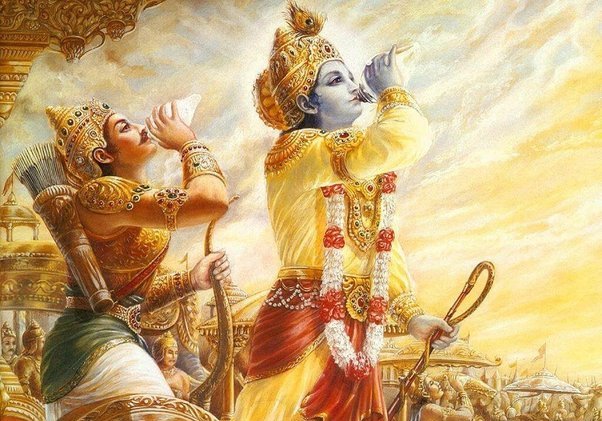In the Mahabharata, the Bhisma Parva (also known as the “Book of Bhisma”) is a significant section that primarily deals with the events that occur during the battle of Kurukshetra, where Bhisma Pitmaha leads the Kaurava army against the Pandavas.
Every great warrior of Mahabharata had a special conch. In those days, a warrior could be identified by the sound of his conch. During the battle, various celestial conches were blown to signal the commencement of each day’s fighting or to announce significant events.
The blowing of celestial conches served multiple purposes:
- Order of Battle: Each day of the battle would begin with the blowing of conches to signal the start of fighting, marking the commencement of the battle for that day.
- Signal for Specific Events: Conches were also blown to signify specific events, such as the entry of prominent warriors into the battlefield, the death of a significant warrior, or the end of the day’s fighting.
- Motivation and Psychological Impact: The sound of conches was also used to motivate the soldiers and boost their morale. It was considered auspicious and inspiring.
Notable warriors on both sides of the conflict, including major characters like Bhishma, Drona, Karna, Arjuna, Yudhishthira, and others, typically blew these conches. Each warrior had a unique conch, which had its distinct sound.
Chapter 1, Verse 15, and Verse 16 of the Bhagavad Gita mention the conch shells used by Lord Krishna and the Pandavas.
पाञ्चजन्यं हृषीकेशो देवदत्तं धनंजयः।
पौण्ड्रं दध्मौ महाशङ्खं भीमकर्मा वृकोदरः।।1.15।।
Verse 1.15:
"Panchajanyam Hrishikesho Devadattam Dhananjayah,
Paundram Dadhmau Mahashankham Bhimakarma Vrikodarah."
Translation:
“Hrishikesh (Krishna), the Lord of the senses, blew the conch shell named Panchajanya, and Dhananjaya (Arjuna) blew the conch shell Devadatta. Bhima, the doer of formidable deeds, blew his mighty conch shell Paundra.”
अनन्तविजयं राजा कुन्तीपुत्रो युधिष्ठिरः।
नकुलः सहदेवश्च सुघोषमणिपुष्पकौ।।1.16।।
Verse 1.16:
"Anantavijayam Raja Kuntiputro Yudhishthirah,
Nakulah Sahadevashcha Sugoshamanipushpakau."
Translation:
“King Yudhishthira, the son of Kunti, blew the conch shell named Anantavijaya. Nakula and Sahadeva blew the conches Sugosha and Manipushpaka.”
| Name of the person | Name of the Conch |
| Krishna | Panchajanya (पाञ्चजन्य) |
| Arjuna | Devadatta |
| Bhima | Paundrak |
| Yudhisthira | Anantavijaya |
| Nakula | Sughosa |
| Sahadeva | Manipuspaka |
However, the Vyasa neglects to list the conches of the Kauravas. Consequently, the conches of Bhishma, Karna, Drona and Duryodhana were not specified.
The Story Regarding Panchajanya
The conch shell named Panchajanya derived its name from a fascinating incident involving Shri Krishna and a devil named Panchan. Aware of Krishna’s daily habit of blowing into his conch shell to signal his availability, Panchan assumed the form of the conch, aiming to suck the life out of Krishna and thereby conquer the world.

However, Krishna, no ordinary mortal, quickly discerned the malicious intent when he noticed something amiss with his conch shell. Instead of falling into his trap, Krishna turned the tables. When Lord Krishna brought the conch to his mouth, he didn’t blow into it but, instead, sucked the air from it. In doing so, he absorbed the life force of the devil Panchan, flipping the roles of executor and victim.
Realizing his grave mistake, Panchan transformed into his proper form and sought forgiveness from Krishna. Krishna transformed him into a natural conch shell and retained it as his possession. The conch, victorious over the devil Panchan, was aptly named Panchajanya—symbolizing the triumph over evil and the divine retribution meted out by Shri Krishna.
How Arjuna Obtained Devadatta?
While burning down Khandavaprastha, the asura named Maya, was trying to escape from the forest. Vasudeva raised his chakra, ready to kill, when he asked Arjuna to save him. Arjuna saved him. This Asura Maya has given Devadatta the supreme Conch Shell, originally owned by Varuna. This conch shell has an excellent sound.
